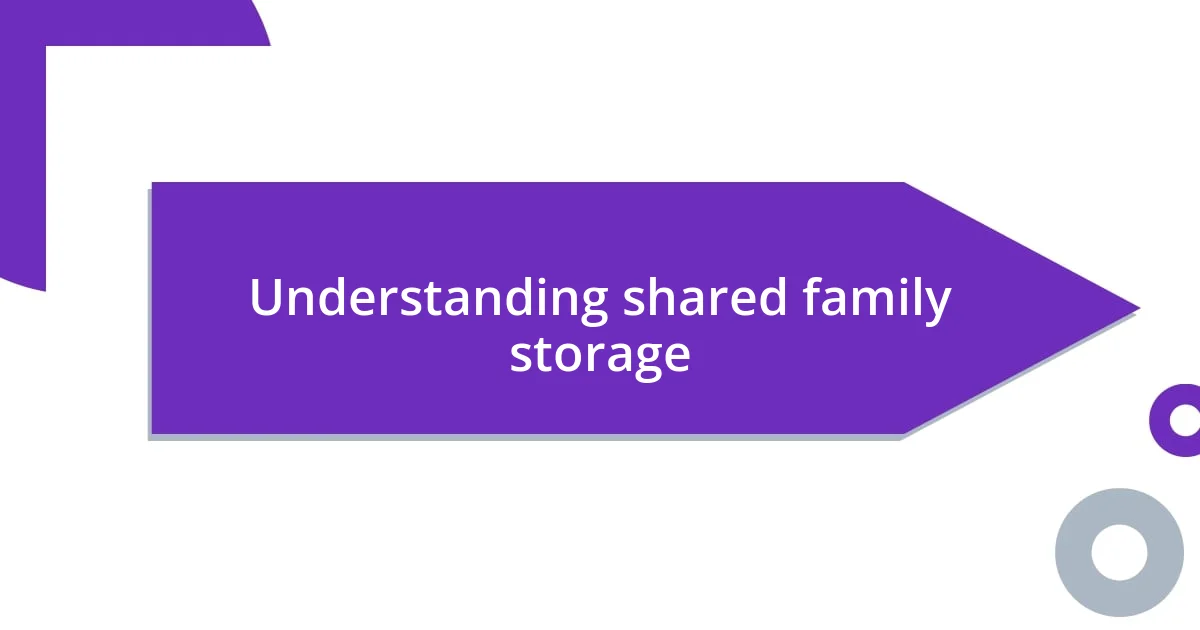Key takeaways:
- Establish shared storage rules and involve family members in organizing to foster respect and cooperation.
- Regularly assess and categorize storage items, ensuring easy accessibility and personal zones for each family member.
- Schedule inventory checks as a family bonding activity, promoting emotional connections to belongings while maintaining organization.

Understanding shared family storage
Shared family storage is a practical solution for managing belongings that can often become overwhelming. I remember setting up a designated area in our garage for seasonal items, like holiday decorations and summer gear. Instantly, it felt like a weight lifted off my shoulders—everything had its place, and disputes over misplaced items decreased significantly.
Navigating shared family storage requires open communication and some emotional intelligence. Have you ever found yourself searching for a tool only to discover a family member had borrowed it without telling you? I’ve been there. Establishing ground rules and understanding each person’s storage needs helps create a space that honors everyone’s possessions while fostering respect and cooperation.
To truly understand shared family storage, we must recognize its impact on family dynamics. I’ve seen how a clutter-free environment can reduce tension and promote teamwork. When everyone feels their belongings are respected and easily accessible, it fosters a sense of belonging and harmony within the home. How can we enhance that feeling even further? By consistently revisiting and reassessing our shared storage strategies together, we nurture both order and family bonds.

Assessing available storage space
When assessing available storage space, I find it essential to take a thorough inventory of what I have and where it is. Recently, I spent an afternoon measuring various areas in my garage and basement. I was both surprised and relieved to discover that, despite a chaotic appearance, I had several hidden nooks that could accommodate additional items if organized correctly.
To effectively assess storage options, consider these key points:
- Measure dimensions: Look for height, width, and depth of the area.
- Identify current usage: Determine what’s being stored and whether it is frequently accessed.
- Evaluate accessibility: Ensure that any storage solution allows for easy retrieval of items.
- Check airflow: Proper ventilation can prevent damage from humidity or mold.
- Plan for growth: Leave room for future items or seasonal changes.
By visually mapping out these aspects, I realized I could fit an extra shelving unit without crowding the space. This simple adjustment brought a sense of accomplishment and clarity—making the storage not just functional but also visually appealing.

Categorizing items for storage
I’ve found that categorizing items for storage is vital in keeping everything organized and accessible. When I tackled our shared family storage, I decided to group items by their function and frequency of use. For instance, I placed all the holiday decorations in one bin and all the sports gear in another. This way, when it’s time to decorate for the holidays or gear up for a game, everything is easy to find. Can you relate? Imagine the satisfaction of not digging through boxes for misplaced items!
To take this a step further, I also designated specific zones for each family member’s belongings. By understanding what each person values and uses most often, the whole process became more personal. I remember when we organized my daughter’s craft supplies—she was so thrilled to see her artwork and supplies neatly arranged in a dedicated spot. Not only did it make retrieval easier, but it also sparked her creativity by showing her the joy of an organized space.
Lastly, I think it’s helpful to regularly revisit and revise these categories. As our lives change, so do our storage needs. When our family purchased a new canoe, for example, we had to rethink our outdoor gear layout. I involved everyone in the process, turning it into a family project. The result? A shared space that reflects all our interests and promotes a sense of ownership over our little corner of the world.
| Category | Description |
|---|---|
| Seasonal Items | Holiday decorations, winter gear, and summer supplies |
| Personal Belongings | Individual items specific to family members, like clothing or hobbies |
| Tools & Equipment | Gardening tools, auto supplies, and outdoor gear |
| Sports Gear | Items related to family sports activities, from bicycles to balls |

Implementing a labeling system
Creating a labeling system is the next logical step in my storage organization journey. I’ve discovered that clear labels not only help in identifying items swiftly but also promote accountability among family members. For instance, when I labeled each bin with specific categories like “Camping Gear” or “Winter Apparel,” it was fascinating to see how much more motivated everyone was to put things back in their designated spots. Do you ever feel that labeling transforms chaos into order?
I made it a point to involve my kids in the labeling process. I encouraged them to design the labels, letting them use their creativity with colors and illustrations. Watching their excitement as they crafted unique labels not only made it a fun activity but also instilled a sense of pride in our shared storage space. It’s amazing how a simple, personal touch can boost engagement—having my daughter create “Art Supplies” with her artistic flair was a game changer.
To keep it functional, I opted for a combination of written and visual cues. While I love a straightforward label like “Board Games,” I found that adding a picture of the game box helped my younger child recognize where things belong. This approach fosters a clearer connection to the items stored away and encourages responsibility. Have you ever thought about how much easier it could be for younger family members to participate in this organization? It’s all about finding the right balance between clarity and personalization.

Scheduling regular inventory checks
Scheduling regular inventory checks is something I can’t emphasize enough. Initially, I thought it would be a chore, but I quickly learned it could be an enriching family activity. We set a designated time each season to go through our storage. I remember the first time we did this; it became a mini family reunion, with everyone reminiscing over old toys and unused items. It sparked conversations I didn’t expect, like my son recalling how much he loved a tiny dinosaur from his childhood.
During our last inventory check, I was amazed at how quickly things had piled up. We discovered an entire box of unused gifts from last Christmas. Instead of feeling overwhelmed, we turned it into a fun session of “what’s your treasure?” Each family member picked out one item to keep, while others went into the donation bin. Establishing a regular schedule not only keeps our space clutter-free but also gives us a chance to connect emotionally with our belongings and each other. Who knew tossing out the old could lead to such heartwarming discoveries?
I’ve found that setting reminders on our calendars helps us stay consistent with these checks. It became a tradition, so much so that my daughter now considers it a rite of passage every season. I ask her, “What are you most excited to see again?” Her enthusiasm always makes me smile and reinforces the benefits of being mindful about what we store. It’s such a rewarding process, merging organization with family bonding—do you think your family would enjoy making this a tradition too?

Encouraging family participation
Involving family members in shared storage tasks can truly be transformative. I recall one weekend when we decided to each choose a section of the storage area to organize. My son excitedly tackled the toy section, while my partner and I focused on seasonal décor. As we uncovered forgotten treasures, like old board games and holiday decorations, laughter echoed throughout the house, and it made the task feel like a playful adventure instead of a chore. Doesn’t sharing the load make cleaning feel less daunting?
One effective way I’ve found to foster participation is by encouraging everyone to set their goals for the space. For instance, I once asked my daughter, “What’s one thing you’d love to find easily next time?” She replied excitedly that her art supplies were always a hassle to dig through. That moment sparked our redesign of her section, turning it into a mini art center. Watching her enthusiasm surge when the area was neatly organized was so rewarding. Isn’t it wonderful how small acts of involvement can lead to greater ownership and pride in shared spaces?
Lastly, I like to celebrate our organization wins. After a successful organizing day, we often treat ourselves to a movie night or a special dessert. I’ll toss out the question, “What new favorite find do you want to showcase?”, and we take turns sharing. This not only convenes us as a family but reinforces the idea that our storage efforts are essential and worthwhile. Have you tried celebrating your own family’s small victories? It’s a fantastic way to keep everyone engaged and motivated throughout the process.

Tips for long-term organization
Staying organized for the long haul requires a bit of planning and consistent habits. One method that has truly worked for us is designating specific bins for seasonal items and themes. For instance, I labeled each bin for holidays or activities, making it easier to locate decorations or gear when the time comes. The first time we pulled out our Halloween bin, the kids’ eyes lit up as they rediscovered costumes and decorations from years past. Isn’t it amazing how much joy can come from simply knowing where things are?
Another key is to keep a “donate” bin readily accessible. Over time, I noticed that some items hung around the storage for too long, just taking up space. Now, whenever we come across something we no longer use, we toss it straight into the donate bin. Recently, my daughter found an old bike she had outgrown and couldn’t believe she had saved it for so long. Trust me—donating on impulse sometimes leads to the most cathartic feelings, don’t you think? Creating this habit of letting go ensures that our storage isn’t just organized but is also meaningful.
I also recommend a visual reminder of our progress. I created a small photo album of items we’ve successfully donated or altered over the years. Looking back at it, I see not only the clutter we’ve cleared but also witness the stories tied to those items. Every picture tells a tale, even if it’s just a scrap of paper from a birthday party. Reflecting on these moments enhances our commitment to staying organized. How do you capture your organization journey? Documenting it might turn into a cherished keepsake for your family too!














